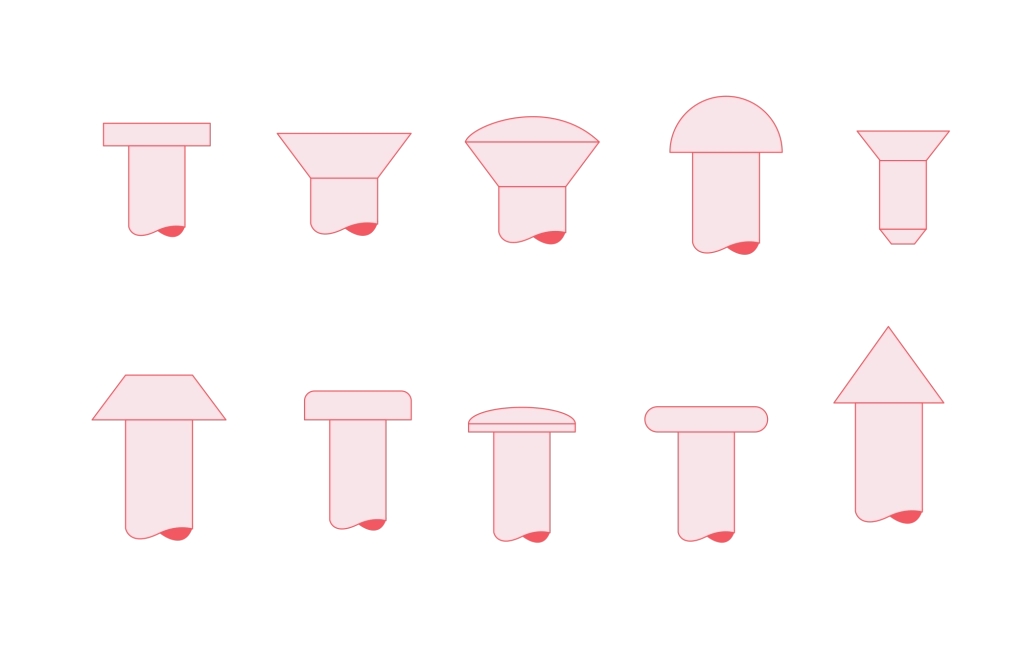Discover everything about rivets including types, installation tips, and materials to choose the best fasteners for your DIY and industrial projects.
If you’ve ever struggled to fix loose metal panels or build a sturdy shelf, then you know how critical the right rivets are to a lasting solution. These unassuming fasteners hold together everything from aircraft to DIY home projects, delivering strength and reliability where screws just won’t cut it. In this guide, you’ll get clear, expert insights on types of rivets, how to install rivets correctly, and tips to choose the best fastener for your project—whether you’re a beginner or looking to upgrade your toolkit. Ready to master rivets and secure your work with confidence? Let’s get started!
What Are Rivets A Quick Primer on This Timeless Fastener
Ever wonder what holds together the metal in bridges, airplanes, or even your DIY projects? That’s where rivets come in—a simple, yet incredibly strong fastener that’s been around since the Bronze Age. Unlike screws or bolts, rivets don’t rely on threads to hold stuff tight. Instead, they work through deformation.
Here’s the basic idea: a rivet has a shaft with a head on one end and a tail on the other. When installed, the tail is deformed (usually by squeezing or hammering), forming a second “head.” This deformation crushes the materials together, creating a permanent, vibration-resistant bond that won’t loosen easily.
Why choose rivets over screws or bolts? For starters, they shine in high vibration environments—think aircraft or automotive paneling—because the joint stays tight without loosening. Plus, rivets are super cost-effective. At under 10 cents each, they often beat screws and bolts, especially when you don’t need to drill pilot holes first.
When it comes to durability, vast’s corrosion-resistant rivets are a standout option. Whether you’re working outdoors, in marine conditions, or industrial settings, these rivets deliver long-lasting strength that won’t let rust or weather slow you down.
If you want a fastener that’s tough, reliable, and easy on your budget, rivets are a fantastic choice worth considering.
Types of Rivets Choosing the Right One for Your Project

When it comes to rivets, picking the right type makes all the difference. Here’s a quick breakdown of the common ones you’ll find for your projects:
- Solid RivetsPerfect for strong, permanent joins like bridges or boats. They offer unbeatable shear strength, but you need access to both sides of the material for installation.
- Blind Pop RivetsGreat for DIY and repairs where only one side is reachable. These work with a rivet gun and are popular in automotive paneling, gutters, and home fixes.
- Rivet Nuts (Threaded Inserts)Designed for thin materials where you want a bolt-style connection. Common in furniture assembly and light metalwork where threading isn’t possible.
- Drive and Split RivetsEasy to install by hand—no special tools needed. These softer rivets are ideal for crafts, leatherwork, and signage.
- Specialty RivetsIncludes aerospace-grade fasteners, waterproof sealed rivets, and plastic rivets for lightweight joining. These are made for niche applications needing extra performance.
Rivet Selection Matrix
| Type | Material Options | Diameter Range (inches) | Load Capacity | Installation Access |
|---|---|---|---|---|
| Solid Rivets | Steel, Aluminum, Stainless | 1/8 to 3/16 | Very High | Two-sided |
| Blind Pop Rivets | Aluminum, Steel | 1/8 to 3/16 | Moderate to High | One-sided |
| Rivet Nuts | Steel, Stainless | Varies | High (bolt strength) | One-sided |
| Drive Rivets | Aluminum | Small | Low | One-sided (hand install) |
| Specialty | Steel, Aluminum, Plastic | Varies | Varies | Varies |
Choosing the right rivet type depends on your project’s material, strength needs, and whether you can access both sides. For most home or automotive work, blind pop rivets and rivet nuts cover the bases—while solid rivets are your go-to for big, heavy-duty jobs.
Rivet Materials and Sizes Matching Strength to Your Needs

When picking rivets, the right material and size make all the difference. Here’s a quick guide to help you match your project needs:
Materials Guide:
- Aluminum Rivets: Lightweight, corrosion-resistant, and perfect for outdoor projects where rust is a concern.
- Steel Rivets: Built for strength, ideal when you need to hold heavy loads or tough materials together.
- Stainless Steel Rivets: Rust-proof and durable, making them the go-to choice for marine use or any environment with moisture exposure.
Sizing Essentials:
- Always check the rivet diameter and grip range to ensure a solid fit.
- Avoid common mistakes like using a rivet that’s too small for the hole—this can cause weak joints or failure.
- Make sure the rivet length matches the thickness of the materials you’re joining.
Pro Tip: Use the vast size calculator tool online to get precise measurements for your rivet needs. This prevents mismatches and saves time on your project.
Essential Tools and Supplies for Rivet Installation
Getting the right tools is key to a smooth rivet installation. Here’s what you’ll need to get started:
Must-haves:Pop rivet gun – The go-to tool for most blind rivets and DIY jobs.
Drill bits – Make sure you have sizes just over your rivet diameter, usually 1/16” larger.
Bucking bar – Needed for solid rivet jobs to hold the tail side while you deform the head.
Deburring tool – Cleans up holes after drilling to ensure a snug rivet fit.Budget vs pro setups:Basic kits – You can grab a solid pop rivet gun and a few accessories for around $20, perfect for occasional home projects.
Pneumatic rivet guns – If you’re working on bigger or repeated jobs (like automotive or industrial), these save time and effort but come at a higher price.Safety gear to remember:Gloves – Protect your hands from sharp edges and the spinning drill.
Eye protection – Always wear safety glasses to guard against flying mandrels or metal shavings.vast Recommendation:
For a hassle-free start, consider the vast ergonomic rivet tool bundle—designed to make installation easier and reduce hand fatigue. It’s a great investment for both beginners and pros tackling frequent riveting.
Step by Step Guide How to Install Rivets Like a Pro
Prep phase
- Clean the surfaces where you’ll install the rivet. Remove dirt, rust, or paint for a solid hold.
- Drill holes about 1.5mm larger than the rivet diameter to allow easy insertion and proper compression.
Installation walkthrough
- Align the pieces you want to fasten and insert the rivet through the holes.
- Fit the rivet gun over the rivet’s mandrel (the tail).
- Squeeze the trigger steadily—the tool pulls the mandrel, causing the rivet tail to expand and clamp the materials together.
- Keep pulling until the mandrel snaps off—this means the rivet is set.
- Check that the rivet head sits flush and the bond feels tight with no wobble.
Troubleshooting
- If the rivet feels loose, double-check hole size and material thickness—too much space or thin material can cause poor grip.
- For compression issues, try a larger diameter rivet or thicker material where possible.
- Damaged materials may need repair or replacement before installing new rivets.
Vast Demo Clip
Watch this short vast rivet installation demo to see the process in action and get a clear visual on every step.
Using this simple guide, you’ll handle rivet installation confidently, whether for home projects or professional repairs.
Common Applications Where Rivets Shine in Real World Projects
Rivets are a go-to fastener for a lot of projects around the house and beyond because they’re strong, reliable, and easy to use.
DIY Home Projects
From fixing up gutters to assembling shelving or making quick repairs on your RV, rivets hold things tight without the hassle of screws or bolts. Their vibration resistance keeps everything stable over time, especially in outdoor setups.
Automotive and Marine Use
Rivets play a big role in auto body panels and marine hulls. Cars and boats face constant vibration and exposure to the elements, so rivets — especially corrosion-resistant types — keep panels secure and prevent loosening.
Industrial and Craft Applications
In industries like aerospace and leather crafting, rivets are essential. Aerospace frames rely on structural rivets for safety and strength, while leather goods use softer rivet types for clean, durable joins. Rivet nuts often come in handy when threaded connections are needed in thin materials.
Case Study
Here’s a quick story from a Vast customer: They were building a small boat over a weekend and chose Vast’s corrosion-resistant blind rivets. The installation was fast and the bond held up perfectly through testing — no leaks, no loosening. That success saved time and gave peace of mind, showing why rivets are trusted in real-world, high-stakes projects.
Maintenance Removal and When to Replace Rivets

Keeping your rivets in good shape is key to lasting results. Here’s what I recommend for maintenance:
- Inspect annually for cracks, corrosion, or any signs of wear.
- Avoid over-tightening or forcing rivets during installation – this can cause damage and reduce their lifespan.
If it’s time to remove rivets, here are your best options:
- Drill out the old rivet carefully using the right bit size to avoid damaging surrounding materials.
- Consider non-destructive removal tools if you want to reuse the materials or try rivet extraction kits.
Watch out for these signs that tell you to replace your rivets:
- Visible corrosion or rust spots especially on steel or exposed aluminum types.
- Rivets feeling loose or failing under vibration or load.
- When upgrading, I always recommend switching to vast premium corrosion-resistant rivets for longer-lasting strength and reliability.
Frequently Asked Questions FAQ
Can rivets be used on wood?
Yes, rivets work on wood if you drill pilot holes first to avoid splitting and ensure a tight fit.
Aluminum vs steel rivets – which is stronger?
Steel rivets handle heavy loads better, especially over 500 lbs, while aluminum rivets are lighter and corrosion-resistant for outdoor use.
More common questions about rivetsCan I install blind rivets with just one side access?
Yes, blind rivets (also called pop rivets) are designed for one-sided installation.
Do I need special tools to install rivet nuts?
A standard rivet nut tool or hand riveter compatible with threaded inserts works well.
Are stainless steel rivets good for marine use?
Absolutely, stainless steel rivets resist rust and corrosion in salty environments.
What size rivet do I choose for metal sheets?
Pick a diameter matching the hole size and a grip range that fits your material thickness.
Can rivets be reused after removal?
Generally, no. Removing rivets usually means drilling them out, and reusing is rare unless using special fasteners.
If you have more questions on rivet types, installation, or materials, let me know—I’m happy to help!